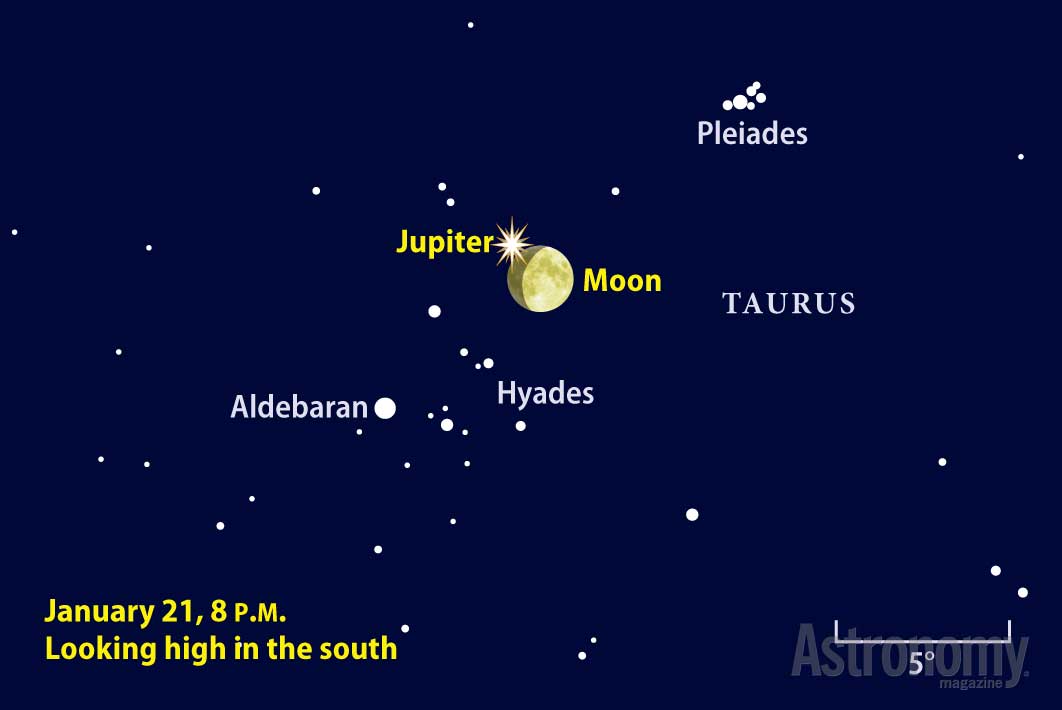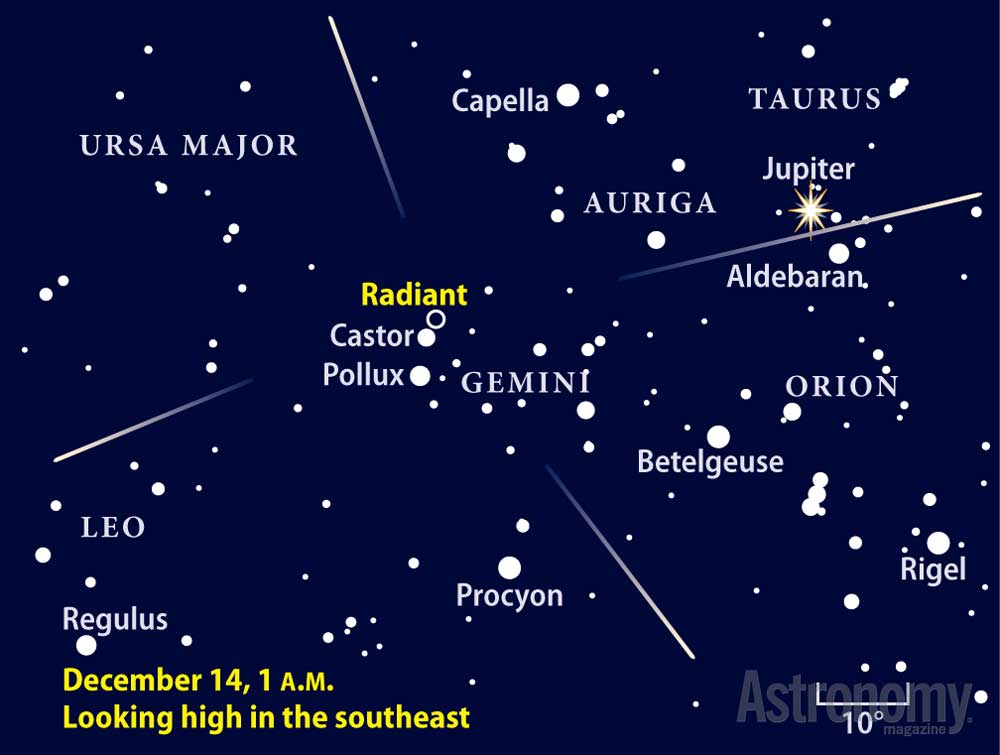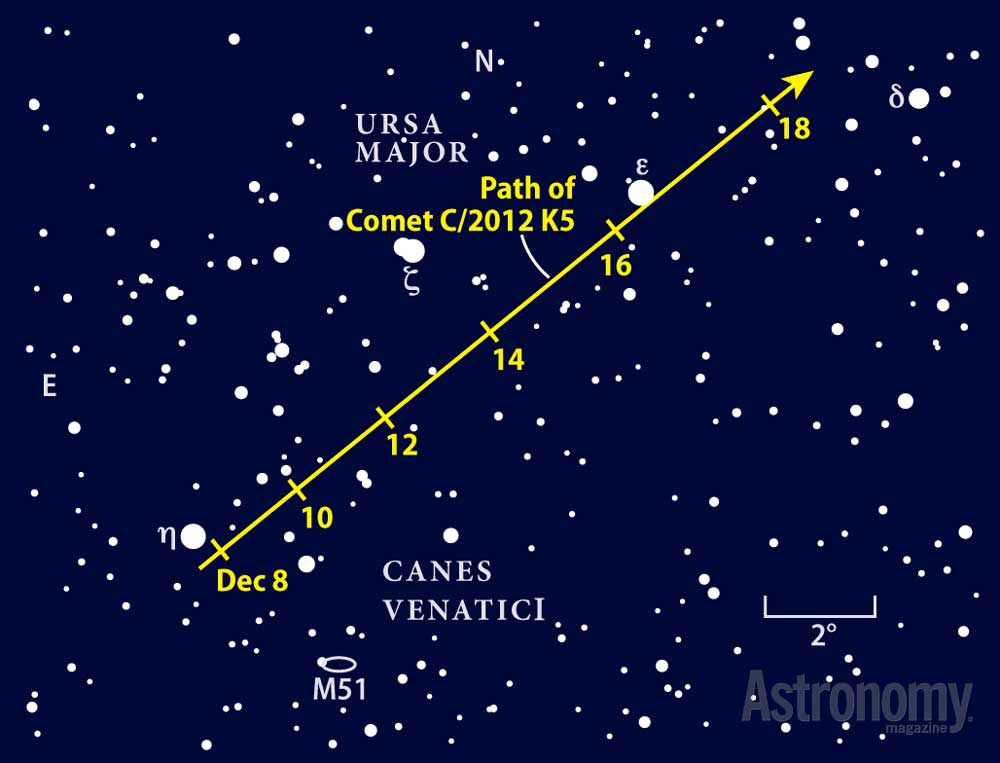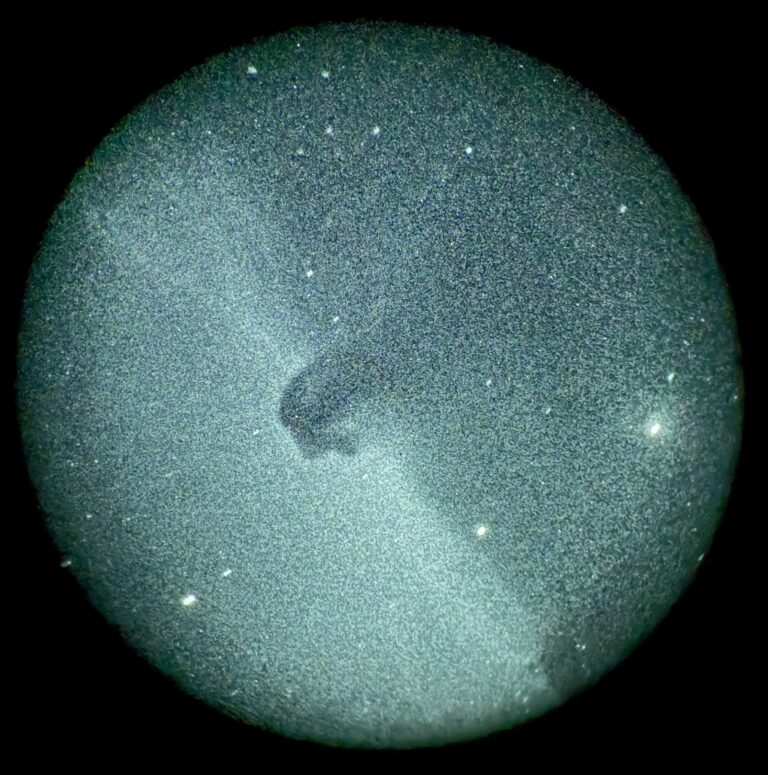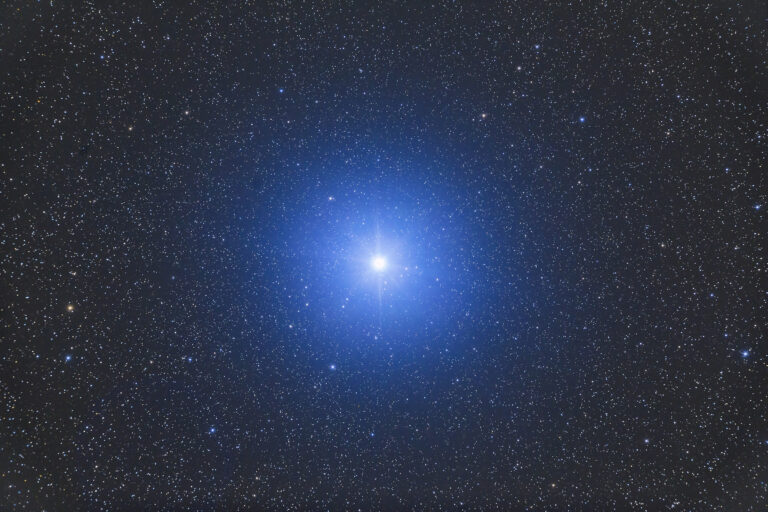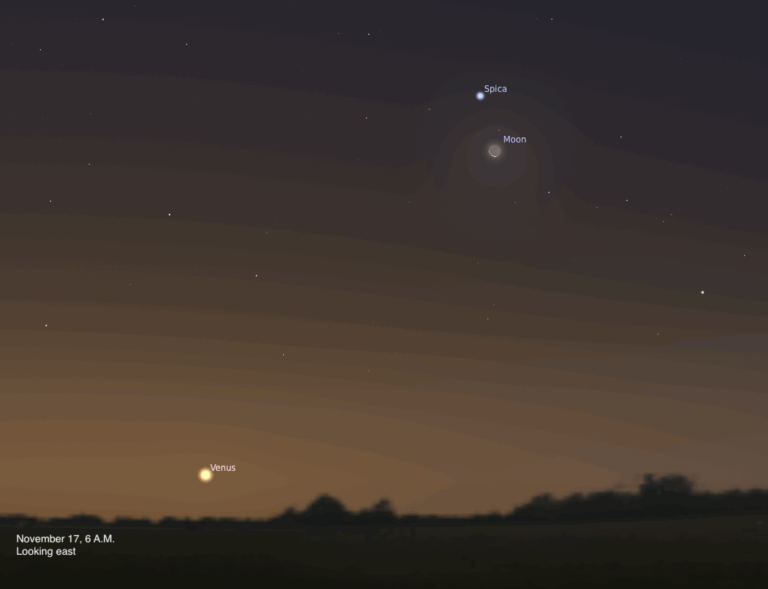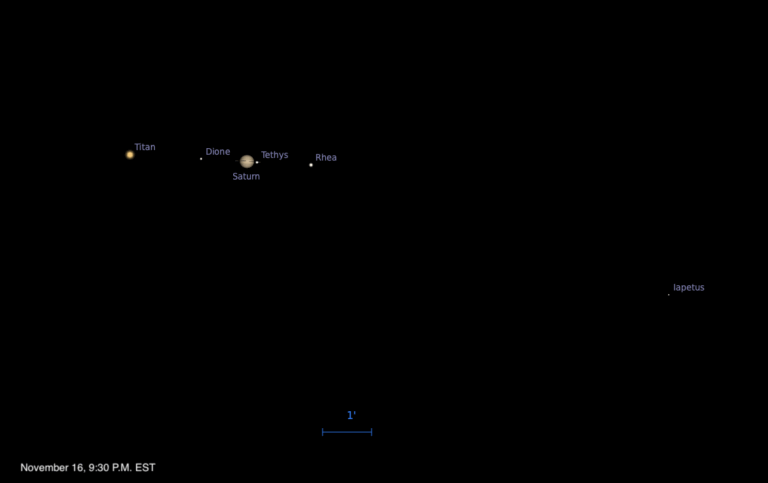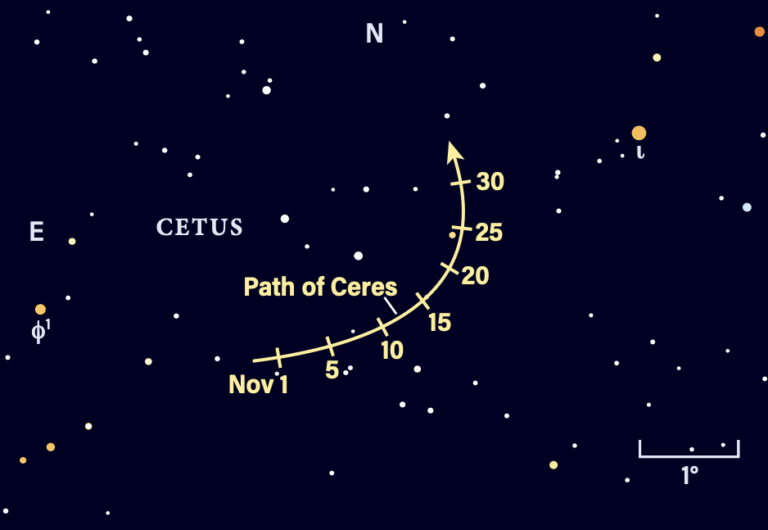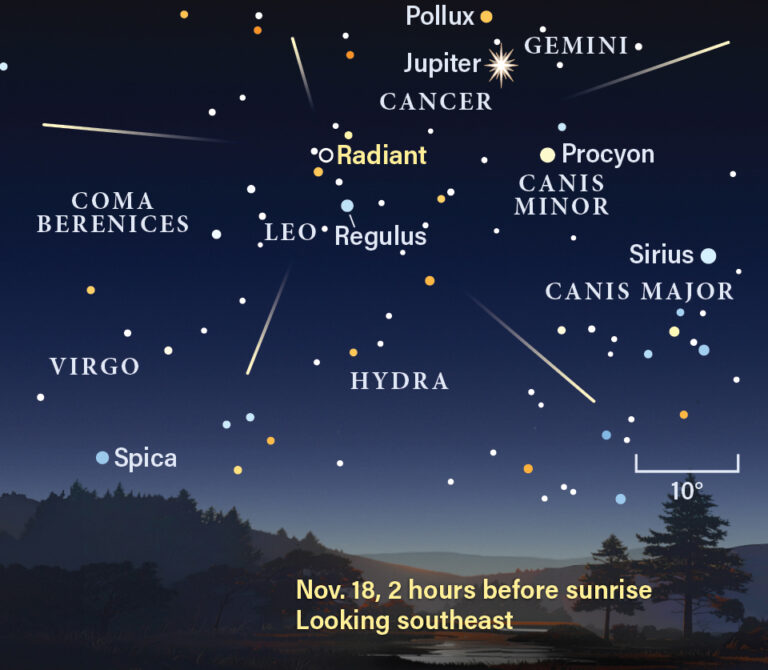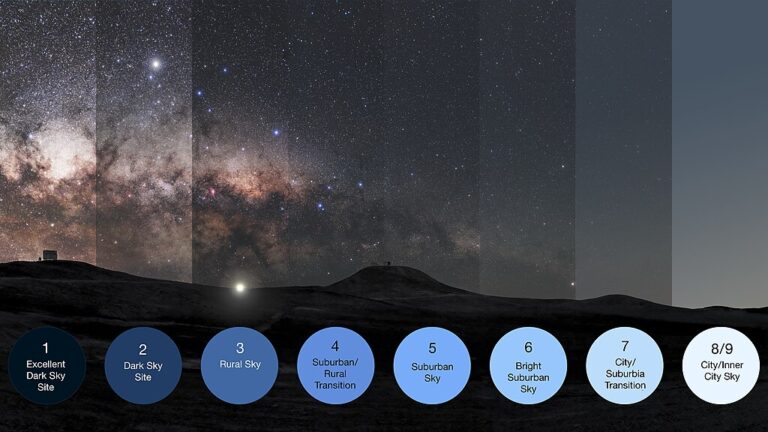Key Takeaways:
Jupiter nestles nicely between the Pleiades and Hyades star clusters in Taurus the Bull, where it dominates the sky from dusk until well past midnight. The more distant giant planets, Uranus and Neptune, occupy the western sky during the evening hours. They ride above our neighbor Mars, which continues its glacial descent into the twilight glow. Early risers can look forward to exquisite views of Saturn and a brief glimpse of Venus.
We’ll begin our tour of January’s sky in the early evening. Mars lingers low in the southwest after sunset all month. Shining at magnitude 1.2, it appears inconspicuous against the twilight background. The Red Planet sets nearly two hours after the Sun on January 1, a value that drops to 90 minutes by month’s end.
Two bright stars flank Mars from a healthy distance. Magnitude 0.8 Altair lies about 30° to the planet’s right and nearly due west 45 minutes after sundown. Fomalhaut stands 35° to Mars’ left and matches the planet’s brightness. Use these stellar beacons to home in on our neighboring world at a slightly lower altitude. Binoculars will help you locate Mars; unfortunately, a telescope shows only a 4″-diameter disk.
If you have a sharp eye, a pristine sky, and an unobstructed horizon toward the west-southwest, you might glimpse Mercury on the month’s final evening. The innermost planet then lies 7° to Mars’ lower right and appears 2° high a half-hour after sunset. Shining at magnitude –1.2, Mercury just might pierce the bright twilight. This world reaches superior conjunction January 18, when it passes on the opposite side of the Sun from our earthly perspective. By mid-February, it will appear as high in the evening sky as it gets this year for observers at mid-northern latitudes.
Neptune stands above Mars and makes a worthy target after darkness falls. It sets four hours after the Sun in early January but dips below the horizon as twilight ends at month’s end. Grab your binoculars and see if you can spot the 8th-magnitude planet among the background stars of Aquarius.
Nearly 35° to Neptune’s upper left lies its ice giant cousin, Uranus. This planet glows at magnitude 5.9 and shows up easily through binoculars. It doesn’t set until late evening, which leaves lots of time for observers to track it down.
Uranus lingers in a sparse region of Pisces, near that constellation’s border with Cetus. This area lies south of the Great Square of Pegasus. To find it, start at Algenib (Gamma [γ] Pegasi), the magnitude 2.8 star that marks the square’s southeastern corner. Uranus lies 14° south of Algenib. Conveniently, magnitude 2.1 Alpheratz (Alpha [α] Andromedae) — the square’s northeastern corner — resides the same distance north of Algenib.
Don’t confuse the planet with 44 Piscium, a nearby star that shines just 0.1 magnitude brighter. In early January, the planet appears 2° west-southwest of the star. That gap dwindles to 1.2° by month’s end. When viewed through a telescope, Uranus shows a distinctly blue-green disk that spans 3.5″.
All these other worlds pale in comparison with Jupiter. The planet reached opposition and peak visibility in early December, and it remains the sky’s “star” from dusk until the wee hours. You can spot Jupiter high in the east within 30 minutes after sunset.
Jupiter dominates a part of the winter sky already rife with bright stars. It lies in central Taurus, just 6° northwest of the Bull’s luminary, 1st-magnitude Aldebaran. The stunning Pleiades star cluster (M45) stands a nearly equal distance to Jupiter’s northwest. At magnitude –2.6, however, the planet shines three times brighter than the sky’s brightest star, Sirius, which rises near the end of twilight.
Jupiter is a wonder to view through any telescope. Earthly meteorologists like to say that if you don’t like the weather, just wait 10 minutes. On Jupiter, this statement is literally true. The giant sphere spins so rapidly, completing a rotation in less than 10 hours, that atmospheric features move noticeably in several minutes.
The speedy spin shows itself in two other obvious ways. First, the equator bulges outward. Jupiter’s equatorial diameter is 7 percent larger than its polar diameter — 45″ compared with 42″ at midmonth, respectively — an effect that’s easy to see through small telescopes. Second, the spin creates turbulence that often shows up dramatically along the borders between the atmosphere’s dark belts and lighter zones.
Equally fascinating are Jupiter’s four bright Galilean satellites. They change positions noticeably from night to night and often from hour to hour. The most exciting alignments occur when a moon and its shadow transit the planet’s disk.
On the evening of January 1, innermost Io and its accompanying shadow show up clearly against Jupiter’s South Equatorial Belt. The moon begins its transit at 6:16 p.m. EST and takes 2 hours and 10 minutes to complete the journey. The darker, more conspicuous shadow hits the jovian cloud tops at 6:59 p.m. EST and takes one minute longer to cross the disk.
Nearly identical early evening events happen January 8, 24, and 31. Be sure to keep your telescope pointed at Jupiter, however, as the January 24 transit winds down.
Europa takes twice as long as Io to orbit Jupiter, so its transits occur half as often. The early evening of January 14 offers a good event for most North American observers. Europa first appears against the planet’s disk at 5:50 p.m. EST and exits at 8:13 p.m. The shadow of the smallest Galilean moon executes a similar trajectory from 7:46 p.m. to 10:10 p.m.
For viewers who enjoy rare sights, watch Jupiter during the year’s first week when the giant planet appears to gain a satellite. From January 2 to 5, the 6th-magnitude double star SAO 76571 lies within 10′ of the giant planet. The double passes closest to Jupiter on the 3rd, when it appears nearer than any Galilean moon. Crank up the power to split the double into its components. You’ll see a nice color contrast between the slightly brighter red giant primary and the blue-white secondary.
Saturn rises shortly before 3 a.m. local time January 1 and some 30 minutes earlier with each passing week. The best views come roughly an hour before dawn, when the planet stands more than 30° high in the south. Saturn lies in Libra, a constellation devoid of bright stars. Shining at magnitude 0.6, it easily outshines its neighbors.
Early mornings are typically cold in January, but nothing stirs the soul better on a frigid night than a view of Saturn through a telescope. The planet’s disk appears 17″ across at midmonth while its rings span 38″ and tilt 19° to our line of sight.
Brilliant Venus rises shortly after twilight begins in early January. Its elongation from the Sun gradually declines during the month, however, and it becomes hard to see low in the southeast by the 31st. The planet glows at magnitude –3.9, bright enough to shine through the twilight. A quick peek through a telescope reveals an almost full disk with an apparent diameter of 10″.
Look for a slender crescent Moon rising with Venus the morning of January 10. Our satellite, less than 35 hours before its new phase, will be hard to see 3° to Venus’ left.
Towering mountain chains and rugged crater walls span the terminator at First Quarter Moon on January 18. This parade of angular features along the day-night divide continues into the evening of the 19th. In the north, the western edge of the large, nearly circular Mare Serenitatis (the Sea of Serenity) gives way to a huge arc of mountains known as Montes Apenninus (Apennine Mountains) that forms the outer ring of the Mare Imbrium (the Sea of Rains) basin.
The massive impact that created this basin threw out an incredible amount of lunar crust. Much of this material was buried soon after when lava erupted through the cracked floor. You can see some of the excavated terrain just southeast of the Apennine chain.
Inside the mountainous arc lies the circular crater Archimedes. On the 19th, the smooth floor acts like a canvas displaying remarkable sawtooth shadows of the crater’s rim. They’re due to the low Sun angle, which exaggerates apparent height.
Look farther north in multiringed Mare Imbrium for the remains of the basin’s inner wall. It shows up as a large number of both isolated and grouped peaks that sprout from the Sea of Rains. The long daggers of darkness that knife westward into the terminator shorten with each passing hour and will nearly disappear a couple of nights later.
The annual Quadrantid meteor shower peaks before dawn January 3. Meteor rates rise quickly to this maximum, which should arrive at 8 a.m. EST (5 a.m. PST). This puts western North America in the prime spot. A waning gibbous Moon shares the sky with the Quadrantids, obscuring dimmer streaks. The Quadrantids generate a high percentage of bright meteors, however, so the shower should still rank among the year’s best.
Under a dark sky in a typical year, the shower produces from 60 to 200 meteors per hour (with an average of about 120). Astronomers suspect that most of this variation arises from the poor weather that often occurs at this time of year and not from intrinsic variations in the shower.
The meteors appear to radiate from a spot in northern Boötes that once belonged to a constellation called Quadrans Muralis. This region climbs some 60° high in the northeast by the time morning twilight begins.
| When to view the planets | ||
| EVENING SKY | MIDNIGHT | MORNING SKY |
| Mercury (southwest) | Jupiter (west) | Venus (southeast) |
| Mars (southwest) | Saturn (south) | |
| Jupiter (east) | ||
| Uranus (southwest) | ||
| Neptune (southwest) | ||
To see Comet C/2012 K5 (LINEAR) at its brightest, plan an evening trip out of town during January’s first week. You’ll want to search for it before the waning Moon rises, which occurs shortly after 9 p.m. local time on the 1st and roughly an hour later each night thereafter. The comet made its closest approach to Earth on December 31, 2012, when it was 27 million miles away. It dims rapidly during January from 10th to 14th magnitude.
C/2012 K5 starts the month in central Auriga, an area that lies high in the eastern sky after darkness falls. On the 2nd and 3rd, it passes between M36 and M37. These 6th-magnitude star clusters make convenient guides for experienced observers. By the 4th, the ball of ice and dust shares a low-power field with 2nd-magnitude Beta (β) Tauri and the 7th-magnitude dwarf planet Ceres (check the finder chart on page 43). If the weather cooperates, this is a great night to track down both LINEAR and Ceres.
The comet continues to dive south, passing 5° east of 1st-magnitude Aldebaran on January 7. By then, you’ll need a 6- to 8-inch scope to get a reasonable view of the 11th-magnitude interplanetary traveler. At low power, you may not be able to see the diffuse dust cloud that surrounds the comet’s pointlike inner coma. So, once you arrive at the right location, pump up the magnification and be sure to keep your observing eye dark adapted.
How’s this for easy? Walk outside, point your binoculars at a bright star, and spot an asteroid in the same field of view. To make things even better, you can perform this task in January with the two brightest asteroids: 1 Ceres and 4 Vesta.
Second-magnitude Beta (β) Tauri is the blue-white star that marks the tip of Taurus the Bull’s northern horn. Just to its south are huge clouds of obscuring dust and cold gas that line the Milky Way. These clouds look impressive through binoculars and wide-field scopes under a dark sky because they lack lots of stars.
The biggest asteroid lies in this sparse region. Ceres glows at magnitude 7.1 to start the month and fades slowly as it tracks along the channel of darkness during the next few weeks. To see the asteroid’s motion against the stellar background, you’ll need to revisit the area every three or four nights.
Vesta has an even brighter guide star. First-magnitude Aldebaran is the starting point for this asteroid, which glows slightly brighter than Ceres. Vesta spends January no more than 3° north of Taurus’ luminary. The background here — formed largely by the Hyades star cluster — is much richer than by Ceres, but the finder chart below should let you pick it out from the distant suns.
Martin Ratcliffe provides planetarium development for Sky-Skan, Inc. from his home in Wichita, Kansas. Meteorologist Alister Ling works for Environment Canada in Edmonton, Alberta.


